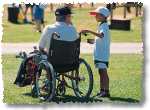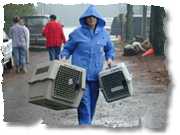When reacting to a disaster, be aware that children, disabled family members, and pets will all most likely slow down your evacuation or preparation steps. You need to take actions as soon as a natural disaster is forecast. Reacting to a false alarm, such as a tornado that veers off to another county or a flood that does not reach your house, is much safer and easier to recover from than waiting too long to make the right decisions. These are three special circumstances that may require additional disaster planning.

 Children
Children
Your children need to understand the possible dangers of natural disasters without living in fear of them. By knowing that you are ready, they will be more at peace. If you give them understanding of what may happen and what your family will do, they gain some control over the possible challenges. A disaster situation can be scary for anyone, but much more so for a child that is taken completely by surprise.
Breaking the normal routine, a natural disaster disrupts a child's world and that causes anxiety, fear, and confusion. The way you prepare for and react to emergencies will have a tremendous impact on how your child will deal with the ongoing risk and the actual event. As the parent, you decide how much to share with and prepare your child based on her age and maturity. Keep these things in mind:
- Teach the warning signs. Enable your children to recognize signals like smoke detectors, fire alarms, and community warning sirens. Also teach them to notice natural indicators such as dark clouds, high winds, thunder, lightning, and tremors.
- Be honest. Explain potential dangers as things that we can not prevent but that we can be ready for. Presenting a danger as a challenge that can be managed is realistic and settling.
- Practice. When you have your family emergency plan devised, practice it with all family members. It will be less scary for real if its been done before.
- Teach how and when to call 9-1-1 for help.
- Have children memorize their name, address, and phone number. Teach them where to meet in an emergency.
- Contain your fear. Children seeing your bravery will be more brave themselves. If they sense you are panicked, they will be more scared. If you lament the loss of your home or possessions, they will feel the loss more strongly. Your reaction will set the tone for their reaction.
- Stay calm and firm. Explain as best you can what has happened and what your family will be doing next.
- Give everyone tasks to do. Simple chores that help with returning to normal can help a child feel valuable and know that things are getting better.
- If an event does occur, as soon as the danger is past, focus on your children's security and emotional needs. Ask him what he is thinking, how he feels, what he thinks we should do now. Make your child part of the recovery process so they feel somewhat in control of their situation.
- Common fears of children preparing for a disaster or going through one are:
- someone will die or be injured
- they will be left all alone
- they will be separated from family members
- the disaster will come back or happen again

 Disabled
Disabled
Extra time may be required to explain the situation and the plan of action to persons impaired of vision or hearing. Some temporary shelters may not be completely accessible so an alternate location may be required.

 Pets
Pets
Red Cross disaster shelters and most other shelters can not take in pets due to health and safety regulations. Exceptions are made for service animals that aid disabled people, such as seeing-eye dogs. You need to include your pets in your family's disaster recovery plan and decide what you will do with them for different types of emergencies that may hit your home.
Keep in mind that an emergency is stressful on animals and may trigger survival behaviors. They may try to hide, escape, or attack. Remember:
- keep pet securely leashed or caged.
- do not leave pets unattended or they may run off.
- do not let children pet or play with pets without you right there with them.
- keep an eye out for strange or aggressive behaviors.
- keep your pet as quiet and comfortable as possible.
If your plan is to evacuate, then you should plan on evacuating your pet also. Leaving a pet behind will most likely result in a lost, injured, or dead animal. Construct a plan now that addresses:
- Safe Place for Pet:
- Friend or relative outside your area that can house your pet.
- Motel at the end of your evacuation route that will accept pets in emergency situations. Keep phone number and make reservations early if you know a disaster is coming.
- Veterinarians or pet boarding services that offer emergency shelter.
- Animal shelters that offer disaster aid.
- Pet Disaster Kit:
-
Just as your family disaster kit contains essential supplies for you, make up a similar kit for you pet that you can grab quickly in an emergency. It should contain:
- medicines and medical records
- first aid kit
- food and drinking water for 3 days
- can opener for food if needed
- eating and bowls, litter pan
- sturdy leash, harness, or carrier to keep your pet secured and safe
- recent photo of pet in case it becomes lost
- instructions on feeding schedule, behaviors, medicinal needs in case you need to drop your pet off with someone else
- name and number of your veterinarian
- small pet toy
- Disaster Preparedness:
- Discuss emergency plans with one or two trusted neighbors. Find one willing and able to evacuate your pet in the event that you are not at home when disaster strikes.
- Check that your pet wears an ID collar with updated information, including name, phone number, address. Add a temporary tag that includes the name, phone number, and address of the friend, motel, or shelter where the pet will be evacuated to.
- As soon as you receive warning of a disaster approaching, start preparing to protect your pet. Like children, pets will require extra time.
- Check that your pet disaster kit is ready and easy to grab.
- Call to make reservations at your pet's evacuation shelter.
- Gather pets inside to eliminate the extra time to search for them when it comes time to leave.
Find Emergency and Disaster Info at www.EmergencyDude.com

